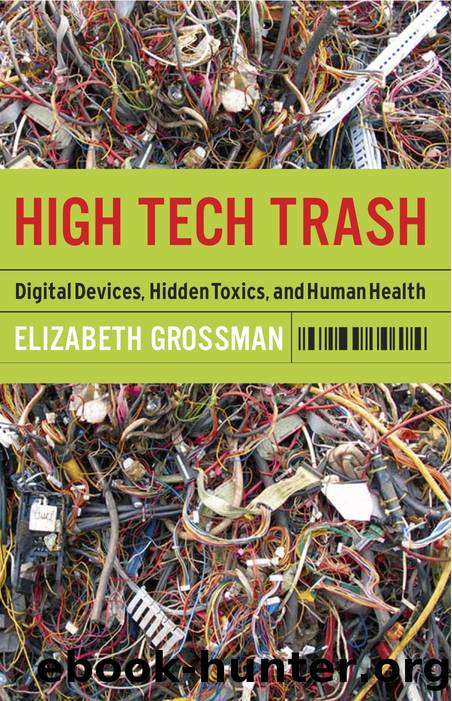High Tech Trash: Digital Devices, Hidden Toxics, and Human Health by Elizabeth Grossman

Author:Elizabeth Grossman [Grossman, Elizabeth]
Language: eng
Format: epub
Tags: computers, General, science, Environmental Science, political science, Public Policy, Environmental Policy, Technology & Engineering
ISBN: 9781597263832
Google: SKt-TCRldvYC
Publisher: Island Press
Published: 2006-05-06T23:43:06.252775+00:00
Even though the European e-waste collection systems include mechanisms to accommodate different manufacturers' financing needs, the NEPSI gang failed to agree on any. Those opposed to charging a fee, visible or hidden, called it a tax and feared it would hurt sales. Proponents of producer responsibility thought the manufacturer should bear the entire recycling fee, though in reality prices would probably reflect that cost. Still another campâprimarily manufacturers with existing take-back programsâwas comfortable with charging fees for recycling and participating in that process, but wanted to retain autonomy and flexibility for themselves rather than have government set the program structure. Older companies like IBM with large amounts of historical waste, and with fewer individual consumers, were more concerned about recouping costs of collecting and recycling older products. There was also disagreement about who should pay for so-called orphaned wasteâelectronics manufactured by companies no longer in business.
The NEPSI group was also uncertain about the role of retailersâsome of whom are also manufacturers in that they sell high-tech electronics under house brand names. An executive from Target who spoke at the 2005 EPA e-waste summit worried that responsibility for explaining recycling fees to customers would be left to the cashier who might be sixteen years old. In early 2005, online receipts from Staplesâthe office supply chainâcame with a note saying, âNote to CA residents: You may have purchased some items that are subject to a recycling charge under the CA Electronic Waste Recycling Act. At this time, Staples has paid this fee for you.â
In the spring of 2002, NEPSI agreed in principle to the idea of charging consumers a take-back fee to enable electronics manufacturers to recover and facilitate recycling of their products. The group then spent the next two years trying to hammer out exactly how such a fee would be levied. In the end, the NEPSI stakeholders agreed that the most workable solution would be some kind of hybrid model that would begin with an advance recovery fee and evolve into a hidden fee (called a partial cost internalization program). But they fell out on how to reconcile this plan with the manufacturers' varying business models and corporate cultures.
In early 2005, after the end of NEPSI discussions, federal legislation was introduced in both the House and the Senate. But neither bill truly addressed how a comprehensive national system of collecting e-waste for reuse and recycling would be financed. The bill introduced by Representatives Mike Thompson of California and Louise Slaughter of New York included a ten-dollar fee on new computers. This fee would fund an EPA program that would direct grant money to municipalities and organizations running electronics recycling programs; manufacturers who have existing recycling programs would be exempt from the feeâa list that would include virtually all major brands. The bill introduced by Senators Ron Wyden of Oregon and Jim Talent of Missouri would grant tax credits to companies and individuals recycling electronics and begin by covering only computers and televisions. But as introduced, the Senate bill had no details for how the recycling itself would be paid for.
Download
This site does not store any files on its server. We only index and link to content provided by other sites. Please contact the content providers to delete copyright contents if any and email us, we'll remove relevant links or contents immediately.
Exploring Deepfakes by Bryan Lyon and Matt Tora(8348)
Robo-Advisor with Python by Aki Ranin(8294)
Offensive Shellcode from Scratch by Rishalin Pillay(6414)
Microsoft 365 and SharePoint Online Cookbook by Gaurav Mahajan Sudeep Ghatak Nate Chamberlain Scott Brewster(5667)
Ego Is the Enemy by Ryan Holiday(5347)
Management Strategies for the Cloud Revolution: How Cloud Computing Is Transforming Business and Why You Can't Afford to Be Left Behind by Charles Babcock(4546)
Python for ArcGIS Pro by Silas Toms Bill Parker(4494)
Machine Learning at Scale with H2O by Gregory Keys | David Whiting(4258)
Elevating React Web Development with Gatsby by Samuel Larsen-Disney(4212)
Liar's Poker by Michael Lewis(3413)
Learning C# by Developing Games with Unity 2021 by Harrison Ferrone(3344)
Speed Up Your Python with Rust by Maxwell Flitton(3297)
OPNsense Beginner to Professional by Julio Cesar Bueno de Camargo(3262)
Extreme DAX by Michiel Rozema & Henk Vlootman(3248)
Agile Security Operations by Hinne Hettema(3169)
Linux Command Line and Shell Scripting Techniques by Vedran Dakic and Jasmin Redzepagic(3159)
Essential Cryptography for JavaScript Developers by Alessandro Segala(3130)
Cryptography Algorithms by Massimo Bertaccini(3071)
AI-Powered Commerce by Andy Pandharikar & Frederik Bussler(3035)
